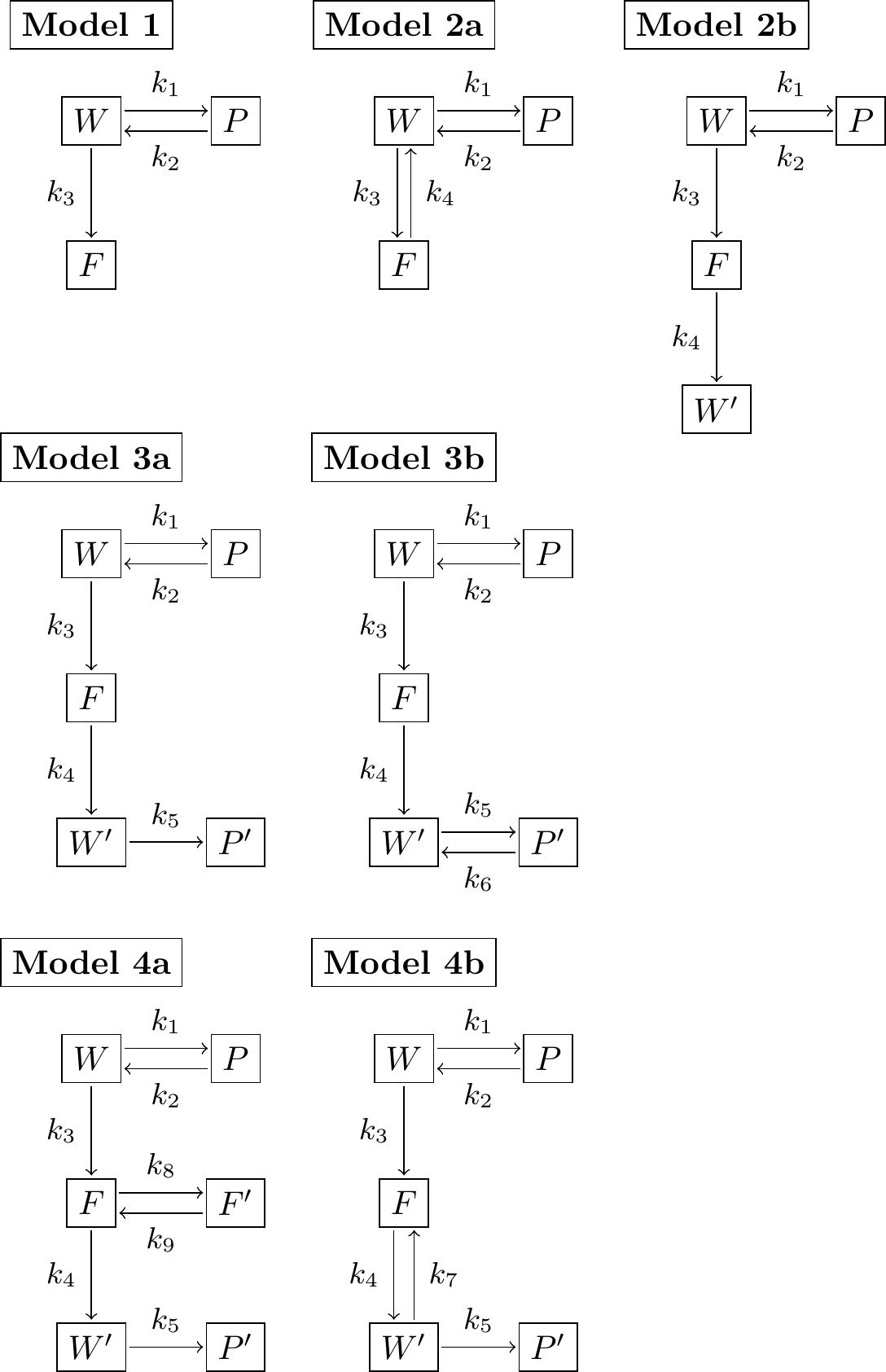3.5 Exercises
Exercise 3.1 Consider the following type of functional responses: \[\begin{align} \mbox{ Type I: } \frac{dP}{dt} &= 0.1 P \\ \mbox{ Type II: } \frac{dP}{dt} &= \frac{0.1P}{1+.03P} \\ \mbox{ Type III: } \frac{dP}{dt} &= \frac{0.1P^{2}}{1+.05P^{2}} \end{align}\]
For each of the functional responses evaluate \(\displaystyle \lim_{P \rightarrow \infty} \frac{dP}{dt}\). Since these functional responses represent a rate of change of a population, what are some examples (hypothetical or actual) would each of these responses be appropriate?
Exercise 3.2 A population grows according to the equation \(\displaystyle \frac{dP}{dt} = \frac{0.1P}{1+.05P} -P\).
- On the same axis, plot the equations \(\displaystyle f(P) = \frac{0.1P}{1+.05P}\) and \(g(P)=P\). What are the two positive values of \(P\) where \(f(P)\) and \(g(P)\) intersect?
- Next algebraically determine the two steady state values of \(P\), that is solve \(\displaystyle \frac{dP}{dt}=0\) for \(P\). (Hint: factor a \(P\) out of the expression \(\displaystyle \frac{0.1P}{1+5P} -P\).)
- Does your algebraic solution match your graphical solutions?
Exercise 3.3 A population grows according to the equation \(\displaystyle \frac{dP}{dt} = 2P - \frac{4P^{2}}{1+P^{2}}\).
- On the same axis, plot the equations \(\displaystyle f(P) = 2P\) and \(\displaystyle g(P)=\frac{4P^{2}}{1+P^{2}}\). What are the two positive values of \(P\) where \(f(P)\) and \(g(P)\) intersect?
- Next algebraically determine the two steady state values of \(P\), that is solve \(\displaystyle \frac{dP}{dt}=0\) for \(P\). (Hint: factor a \(P\) out of the expression \(\displaystyle 2P - \frac{4P^{2}}{1+P^{2}}\).)
- Does your algebraic solution match your graphical solutions?
Exercise 3.5 A chemical reaction takes two chemicals \(X\) and \(Y\) to form a substrate \(Z\) through the law of mass action. However the substrate can also disassociate. The reaction schematic is the following:
\[\begin{equation} X + Y \rightleftharpoons Z, \end{equation}\]
where the proportionality constant \(k_+\) is associated with the formation of the substrate \(Z\) and \(k_-\) the disassociation (\(Z\) decays back to \(X\) and \(Y\)).
Write down a differential equation that represents the rate of reaction \(\displaystyle \frac{dZ}{dt}\).
Exercise 3.6 For each of the following exercises consider the following contextual situations modeling rates of change. Name variables for each situation and write down a differential equation describing the context. Be sure to identify and briefly describe any parameters you need for your model. For each problem you will need to:
- Name and describe all variables.
- Write down a differential equation.
- Identify and describe any parameters needed.
- Write a brief one-two sentence explanation of why your differential equation models the situation at hand.
- Hand sketch a rough graph of what you think the solution as a function of time - note: your solution needs to be consistent with your explanation and vice versa.
- The rate of change of an animal’s body temperature is proportional to the difference in temperature between the environment.
- A plant grows propritional to its current length \(L\). Assume this proportionality constant is \(\mu\), whose rate also decreases proportional to its current value. You will need to write down a system of two equation with variables \(L\) and \(\mu\).
- A patient undergoing chemotherapy receives an injection at rate \(I\). This injection decreases the rate that a tumor accumulates mass. Independent of the injection, the tumor accumulates mass at a rate proportional to the mass of the tumor.
- A cell with radius \(r\) assimilates nutrients at a rate proportional to its surface area, but uses nutrients proportional to its volume. Determine an equation that represents the rate of change of the radius.
- A patient undergoing chemotherapy receives an injection at rate \(I\). This injection decreases the rate that a tumor accumulates mass. Independent of the injection, the tumor accumulates mass at a rate proportional to the mass of the tumor.
- The rate that a cancer cell divides (increases in amount) is proportional to the amount of healthy cells in its surrounding environment. You may assume that a healthy cell has a mortality \(\delta_{H}\) and a cancer cell has mortality \(\delta_{C}\). Be sure to write down a system of differential equations for the population of cancer cells \(C\) and healthy cells \(H\).
- The rate that a virus is spread to the population is proportional to the probability that a person is sick (out of \(N\) total sick and healthy individuals).

Figure 3.7: Reaction schemes.